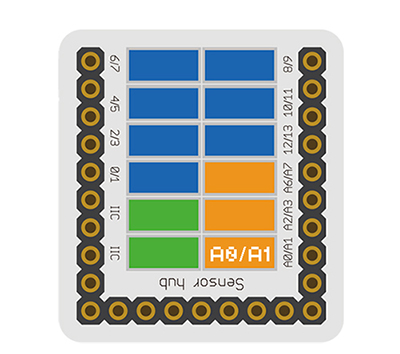Difference between revisions of "Sensor-Moisture"
From Microduino Wiki
| (10 intermediate revisions by 2 users not shown) | |||
| Line 3: | Line 3: | ||
|- | |- | ||
| | | | ||
| − | [[File: Microduino-Moisture.jpg| | + | [[File: Microduino-Moisture.jpg|300px|thumb|right| Sensor-Moisture]] |
| + | The product number of Sensor-Moisture is: MSDT23 | ||
Sensor-Moisture is a soil humidity detection sensor. | Sensor-Moisture is a soil humidity detection sensor. | ||
| + | |||
| + | ==Introduction of Sensor Pins== | ||
| + | {{ST_Pinout | ||
| + | |st_name=Moisture Sensor | ||
| + | |pin3=Analog Input | ||
| + | }} | ||
==Features== | ==Features== | ||
*Resistance-type humidity sensitive component with high sensitivity; | *Resistance-type humidity sensitive component with high sensitivity; | ||
| − | *Low consumption and high stability; | + | *Low consumption and high stability; |
| − | |||
==Specification== | ==Specification== | ||
| − | * | + | *Sensor voltage |
| − | *1.27mm-pitch 4PIN interface; | + | **3.0V~5.5V working voltage |
| − | * | + | *Size of the sensor |
| − | + | **Size of the board: 23.5mm*13mm | |
| − | + | **1.27mm-pitch 4PIN interface connected to sensorhub; | |
| + | **CAD drawing of sensor: '''[[File:Sensor_CAD.zip]]''' | ||
| + | *Technical parameter | ||
| + | **Output: 0~5V analog signal | ||
| + | *Connection | ||
| + | **This sensor can be connected to the following pins of core: A0~A7 | ||
==Document== | ==Document== | ||
| − | *Schematic: '''[[File: Microduino_Moisture.Zip]]''' | + | *Schematic diagram: '''[[File: Microduino_Moisture.Zip]]''' |
| + | *Main sensor: '''[[File:Sensor-Moisture datasheet.pdf]]''' | ||
==Development== | ==Development== | ||
| + | ===Program Download=== | ||
| + | *Download and unzip the program'''[[File:Sensor-Moisture_Test.zip]]''' | ||
| + | |||
| + | ===Programming=== | ||
| + | {{Upload | ||
| + | |nameA=[[Microduino-Core]], [[Microduino-USBTTL]] | ||
| + | |nameB=[[Microduino-USBTTL]] | ||
| + | |boardName=Microduino/mCookie-Core(328p), Atmega328P@16M,5V | ||
| + | |fileName=Sensor-Moisture Test.ino | ||
| + | }} | ||
| + | |||
| + | ===Hardware Setup=== | ||
| + | *Referring to the following diagram, connect the 将Sensor-Moisture to analog pin A0/A1 of '''[[Microduino-Sensorhub]]'''. | ||
| + | <br> | ||
| + | [[file:Microduino-sensorhub_Moisture.JPG|thumb|400px|left]] | ||
| + | <br style="clear: left"/> | ||
| − | + | ===Result=== | |
| + | *After download, open the serial monitor | ||
| + | *The return value of the sensor is "0.00" when it doesn't touch anything, and the value will be larger than 0 when it touches the soil. The displayed value represents the moisture of the soil. | ||
==Application== | ==Application== | ||
| − | + | It can be applied to potted plants, agricultural irrigation, soil loss and other soil moisture detecting situations, and it can serve for irrigation control. | |
| − | |||
| − | |||
| − | |||
| − | |||
| − | |||
| − | |||
==Purchase== | ==Purchase== | ||
Latest revision as of 06:41, 4 August 2017
| Language: | English • 中文 |
|---|
|
The product number of Sensor-Moisture is: MSDT23 Sensor-Moisture is a soil humidity detection sensor. ContentsIntroduction of Sensor Pins
Features
Specification
Document
DevelopmentProgram Download
Programming
Hardware Setup
Result
ApplicationIt can be applied to potted plants, agricultural irrigation, soil loss and other soil moisture detecting situations, and it can serve for irrigation control. PurchaseHistoryPictures
File:Microduino-Moisture-F.JPG Microduino-Moisture Front
File:Microduino-Moisture -b.JPG Microduino-Moisture Back |


